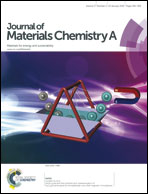Microwave-assisted preparation of self-doped TiO2 nanotube arrays for enhanced photoelectrochemical water splitting†
Abstract
We report a microwave-assisted chemical reduction method with NaBH4 to prepare bulk abundant Ti3+ self-doped TiO2 nanotube arrays (MR-TNTs). UV-vis diffuse reflection spectra show that the light absorption spectrum range of MR-TNTs extends from the UV to visible light region and the electrochemical impedance spectra indicate that the induced oxygen vacancies of MR-TNTs enhance their electrical conductivity as well as charge transfer. The MR-TNTs show an 8-fold increase in visible light photocurrent density compared to the pristine TNTs, and the optimized saturation photocurrent density and photoconversion efficiency under AM1.5 irradiation are identified to be 3.05 mA cm−2 at 1.23 V vs. RHE and 1.66% respectively, which are the highest values ever reported for doped TNT photoelectrodes. The incident photon to current conversion efficiency (IPCE) spectrum increases both in UV and visible light regions. Moreover, the MR-TNTs exhibit much more stable PEC performance than the NaBH4 treated TNTs without microwave assistance, which is attributed to the self-doped Ti3+ mainly existing in the bulk rather than on the surface.


 Please wait while we load your content...
Please wait while we load your content...